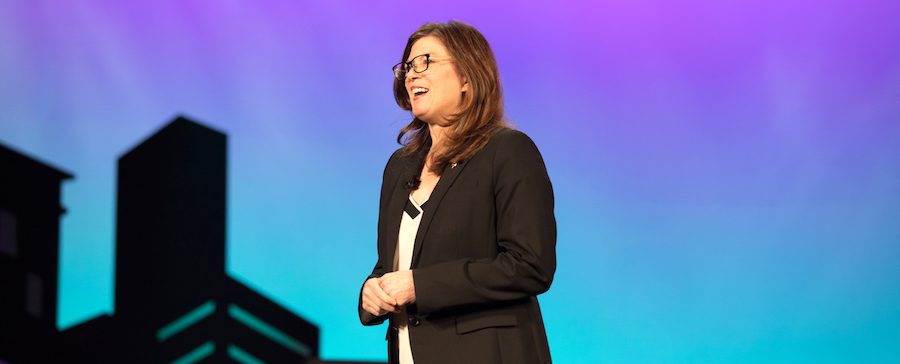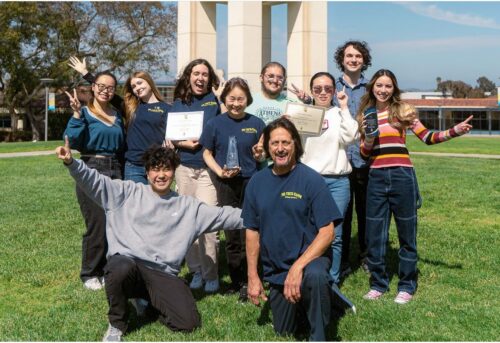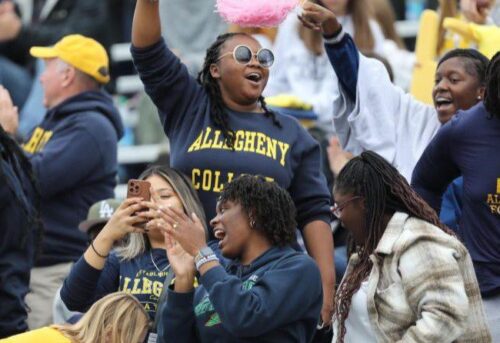Editor’s Note: This is a transcript of the speech given by Phi Theta Kappa President and CEO Dr. Lynn Tincher-Ladner at PTK Catalyst 2019. It has been edited for clarity. You can also watch it here.
There is so much talent in this room. This year’s International Officers would say you guys “drip talent.”
I’ve always known I wanted to be an educator, but lately, I find myself more in the role of learner and less in the role of teacher every day. And who am I learning from? I’m learning from you — the amazing students of Phi Theta Kappa, and my talk today is about that.
What am I learning from you, and how does that apply to my work and into the direction and the vision of this organization?
I recently had someone ask me, “As President and CEO of Phi Theta Kappa, what is your ultimate goal?”
And I had to stop and think about that. Those “big picture” goals and of those, what is the biggest? I mean, I have goals to strengthen our current programs, create new ones, find more scholarships for you, and find more opportunities for you to grow in meaningful ways, but that wasn’t what she was asking me.
My answer spanned my entire career, not just my time at PTK, and I explained that it is my life’s work to make it known that community colleges are quality institutions…and home to the best and brightest students this nation has to offer.
We have to be honest. We know there’s a widespread belief that community colleges are less than four-year private and public colleges. Some call it a “community college stigma,” but it’s much worse than that. To me, it’s an unfounded belief system that parents, they don’t even realize they’re teaching it to their children. Psychologists refer to this as “a shared delusion.”
My evidence, and for those of you who know me in my former life as an institutional researcher, “evidence” is just not a word I throw around. It’s not lip service. There’s actual proof, and you, the members of Phi Theta Kappa, are the best evidence of the quality of our nation’s colleges.
Evidence is something that when you see it, you believe it, right? So, let me tell you a personal story about evidence that has to do with my children, Lauren and Lucas. When they were really little, we moved from a house that had a chimney and a fireplace to a smaller home that didn’t, and as Christmas approached, they were asking me probing questions about how would Santa, in the absence of a fireplace, deliver their toys and gifts to them?
I assured them Santa was magical and that he would find a way to deliver the gifts. And Christmas morning, I went upstairs, and I said, “You must come downstairs and help me clean up this enormous mess that Santa has left.”
They went downstairs and the couch was turned over, the pillows were everywhere, there was dirt everywhere, there was a broken cookie plate, half-eaten carrots in the corner. And those children, they believed that Santa is magical and will deliver gifts to good, little children like Lauren and Lucas.
But today, I want to share a different kind of evidence — things that I’ve learned about you and from you. Things that show proof that you are amazing students, and our colleges are amazing places of learning. At any given time, about one-third of students in higher education are in the community college, but that statistic does not show the entire story, because it doesn’t include our transfer work.
Last year, our colleges, the communities — and the nation’s community and technical colleges, we produced about 1.2 million associate degrees and certificates. It gets much better than that.
At that same time, four-year colleges and universities, they produced 1.9 million bachelor’s degrees, but the research says 49 percent of those bachelor’s degrees were from community college transfers. And in Texas, that number is 75 percent. And Oklahoma, it’s 64 percent in your state.
Community colleges provided an impact to over 2.1 million degrees and certificates last year. We are the nation’s superpower of education, and you fuel that!
And when you transfer, how do you do? Well, many years ago, I worked for Mississippi Gulf Coast Community College. Every year, I studied our transfers, and every year, the transfers from our college outperformed the students in the universities. And I really thought it was just our school, because it was such a great school, and then I had a chance to do some work for Ozark Technical Community College — same thing there.
And in my work with accreditation, I found the same thing at Pasco-Hernando Community College in Florida, and at Jefferson State Community College in Alabama, and the entire Dallas Community College System, the whole thing.
And I could go on, because I have stepped foot on hundreds of campuses in this country, many of which you attend, getting those same results. Community college students like you who transfer to universities do just as well as the students that start there, and you, Phi Theta Kappa, you do better!
And then if you fast-forward to 2016, I was at a meeting of the American Association of Community Colleges, and a couple of researchers were presenting some findings on community college transfer, and they presented this graph. And this graph had on it the GPA, the average GPA, along the Y axis and over time in semesters along the X, and there was this red line.
The red line represented the average GPA of community college students, and then they had this blue line, and this was the average GPA of native university students that started there as freshmen.
Now, when you conduct these studies in these individual schools, those are called “case studies.” This graph was an entire state. This was the state of Virginia. And in the middle is the average point of transfer. So, to the left is the first years of community college, and to the right would be their performance at the university. And this was my favorite graph, I showed it to everyone. It was as if I found a new element on the periodic table — look at this!
And then, this was my favorite graph until I received an email just a few months ago from the executive director of the Jack Kent Cooke Foundation. And he said, “You may find this study interesting.”
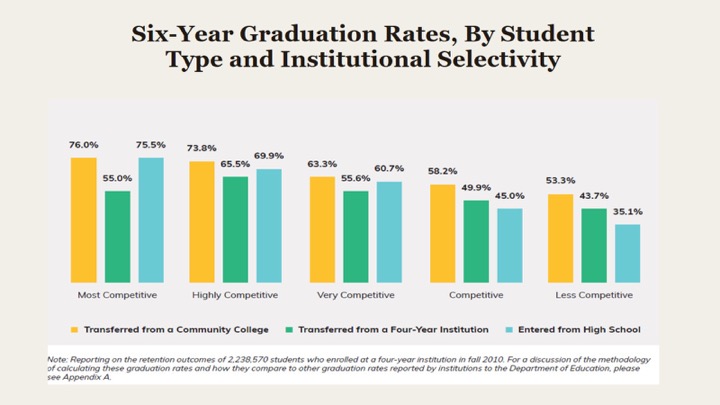 And that was the understatement of the century, because there it was, a national study of over 2.5 million students who are going to four-year colleges and universities.
And that was the understatement of the century, because there it was, a national study of over 2.5 million students who are going to four-year colleges and universities.
And what this study did is it divided these students into three groups — one was community college transfers, another was transfers from four-year to four-year, and then a third group was students that started at the university as freshmen. And what happened in this study is that they look at these students over a six-year period and look at their completion rates, and now I have a new favorite graph.
You see that yellow line? That’s community college transfers. And I have another new favorite graph, another new favorite graph, and another, and another. Because as you can see, even in the most selective of colleges and universities, community college transfers do better.
So, what I need for you to know is that the narrative that “community colleges are not good enough” is simply not true, and we have the evidence to prove it. And if you’re not seeing that, then you’re not paying attention.
But the evidence is mostly right here in this room, to me. It’s in our amazing advisors like Jo and Steve Fritts and Kari Kahler. It’s in supportive college presidents like Susan Looney and Joyce Ester. It’s in the great instruction that you get inside the classroom and the amazing extracurricular activities, like Phi Theta Kappa, that you participate in outside the classroom. We see it in our successful transfers like Amanda Karpinski, Ebonee Carpenter, and Michael Aguilar.
It’s in our community college graduates who are in the workforce like Sydney Pemberton, David Kerr, and Feifei Zeng. And I could keep going with that list, but the evidence is right in front of you, and it’s all around you. And the next time you look in the mirror, you are the evidence of that quality, and that is just the proof of it.
And besides being amazing places of learning, community colleges are amazing places of opportunity. And speaking of opportunity, here is some advice — opportunity is not going to hunt you down. You have to look for it, you have to take advantage of it, and when you first see it, it may not even look like opportunity, and that’s the hard part.
The student that taught me this the most is OB (Obinna) Muoh. OB never met a single situation that he did not see opportunity. This young man has had more obstacles in front of him than most of us in this room will ever know, but I’m really not sure he ever saw them as obstacles. He saw them as opportunities. Opportunity for him to grow and learn and to create lasting friendships, and to eventually reach his ultimate goal of being a chemical engineer. I know OB will reach his goal, just like many of you will in this room.
But, you know, Phi Theta Kappa, you are more than just the evidence of what community colleges have to offer. You are evidence of what you have to offer. Yes, you’re a member of this amazing organization, but you stand alone, and you are fearless learners, you are master jugglers, and you are second-chance takers.
Phi Theta Kappa, you are the champions, and I am so proud to be yours.
